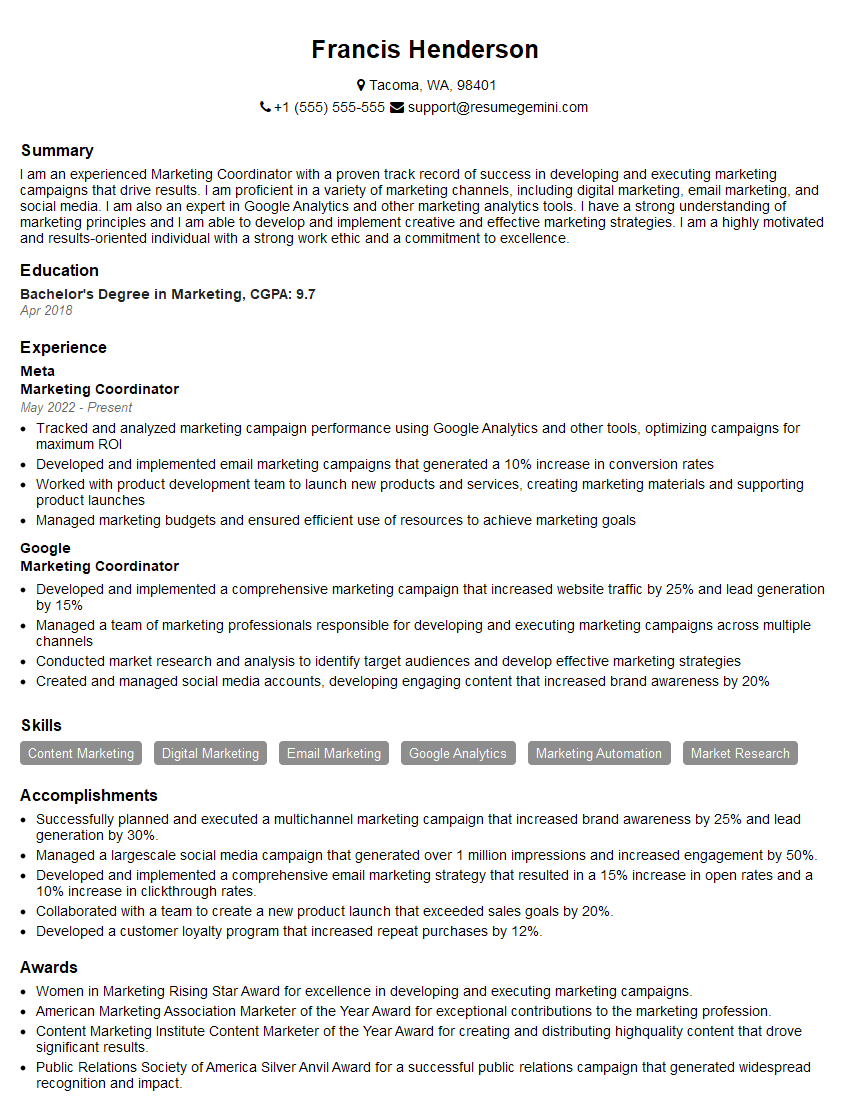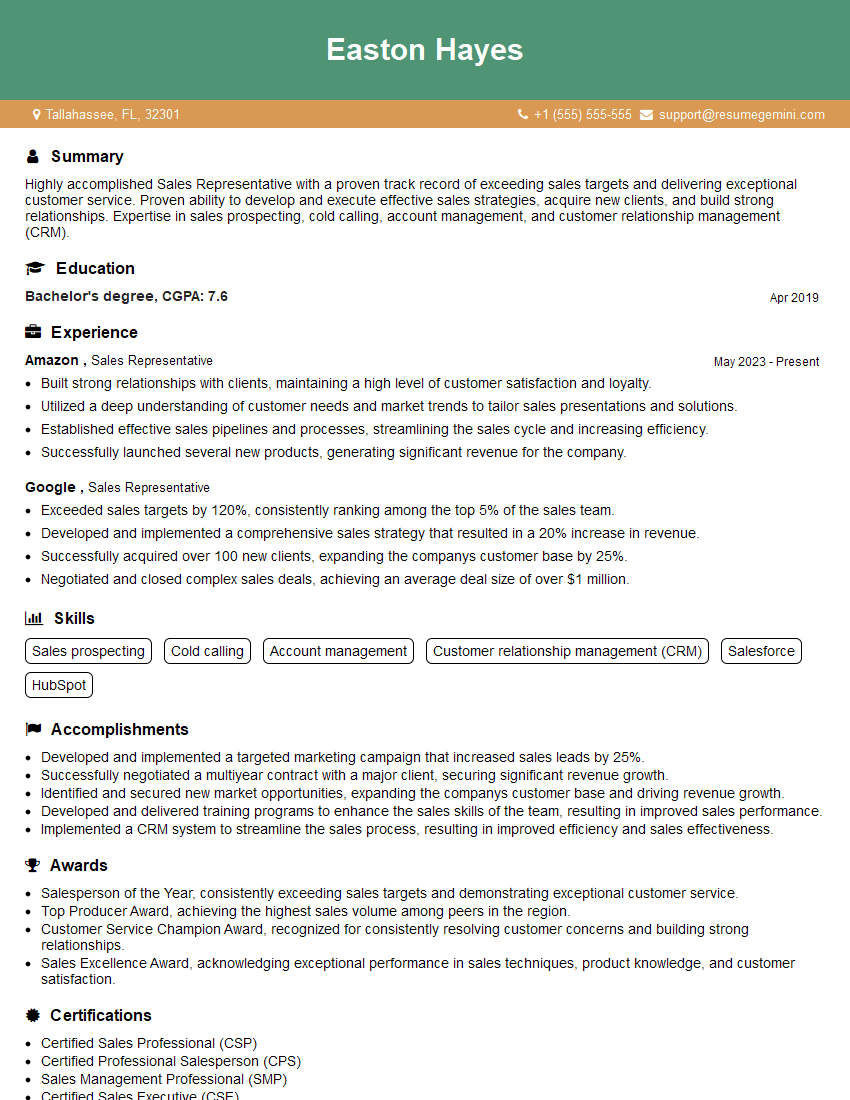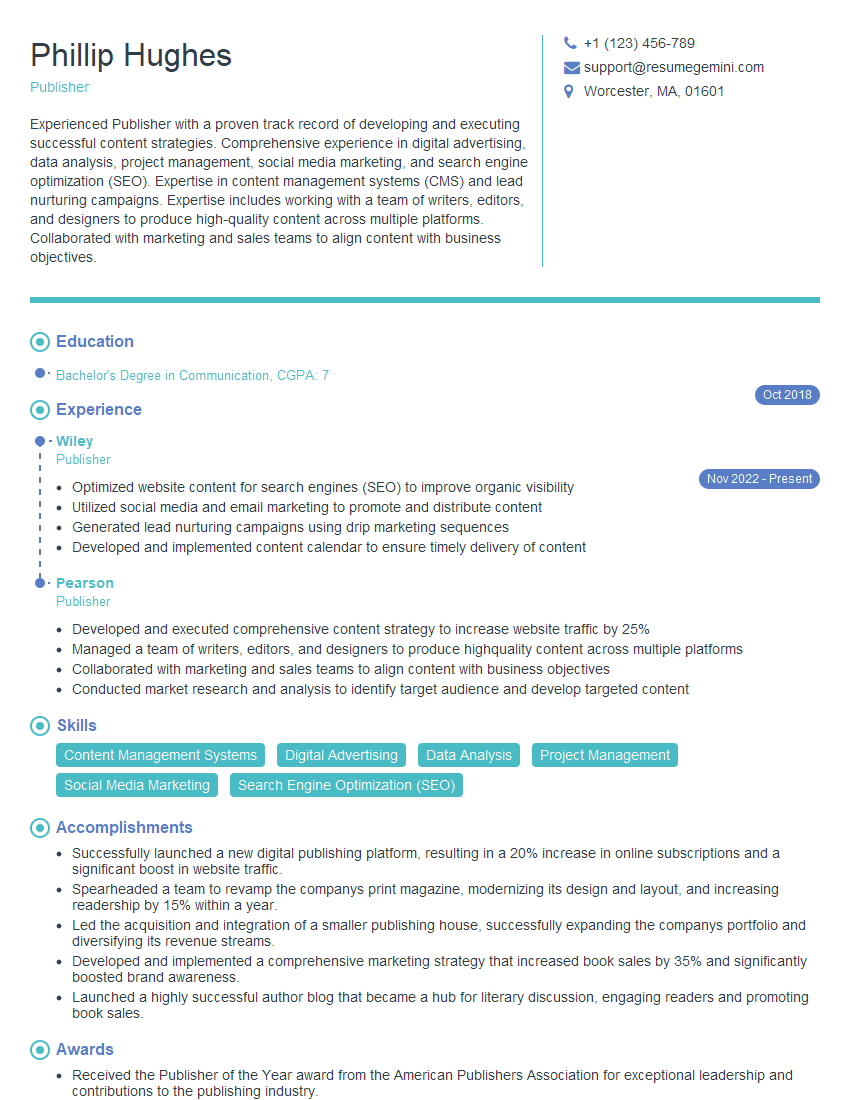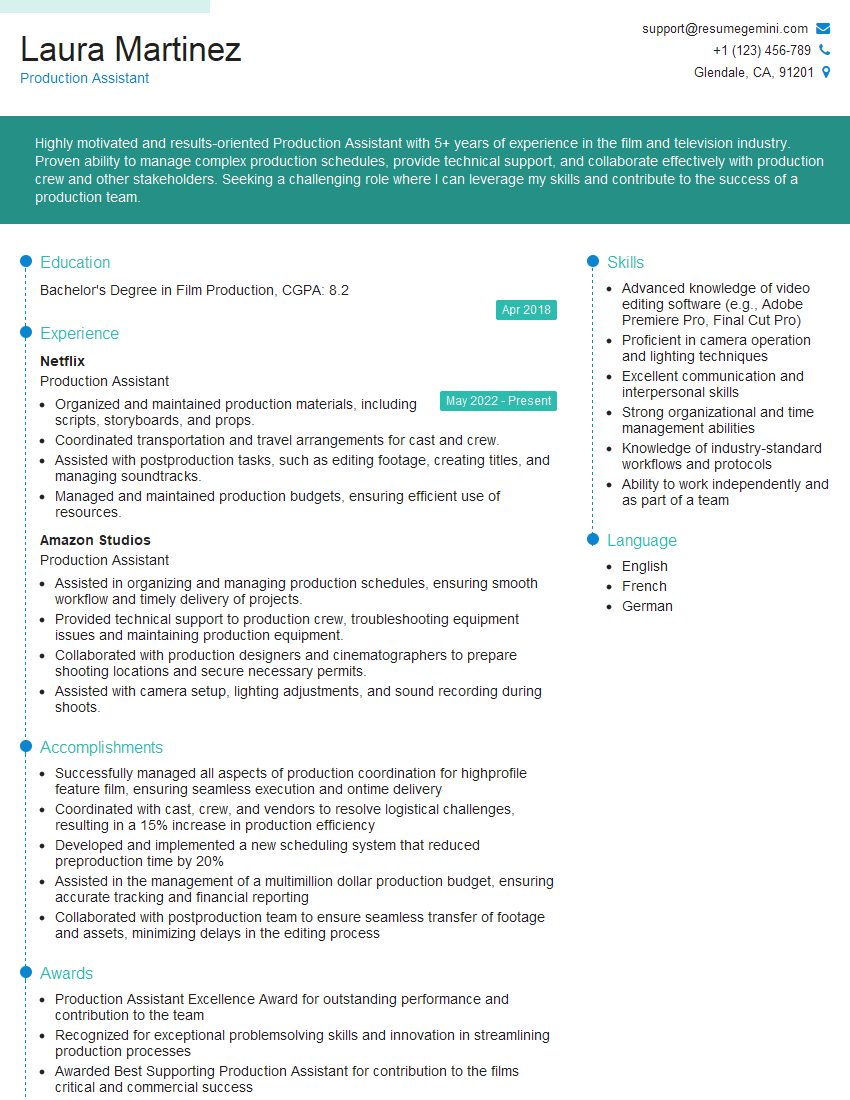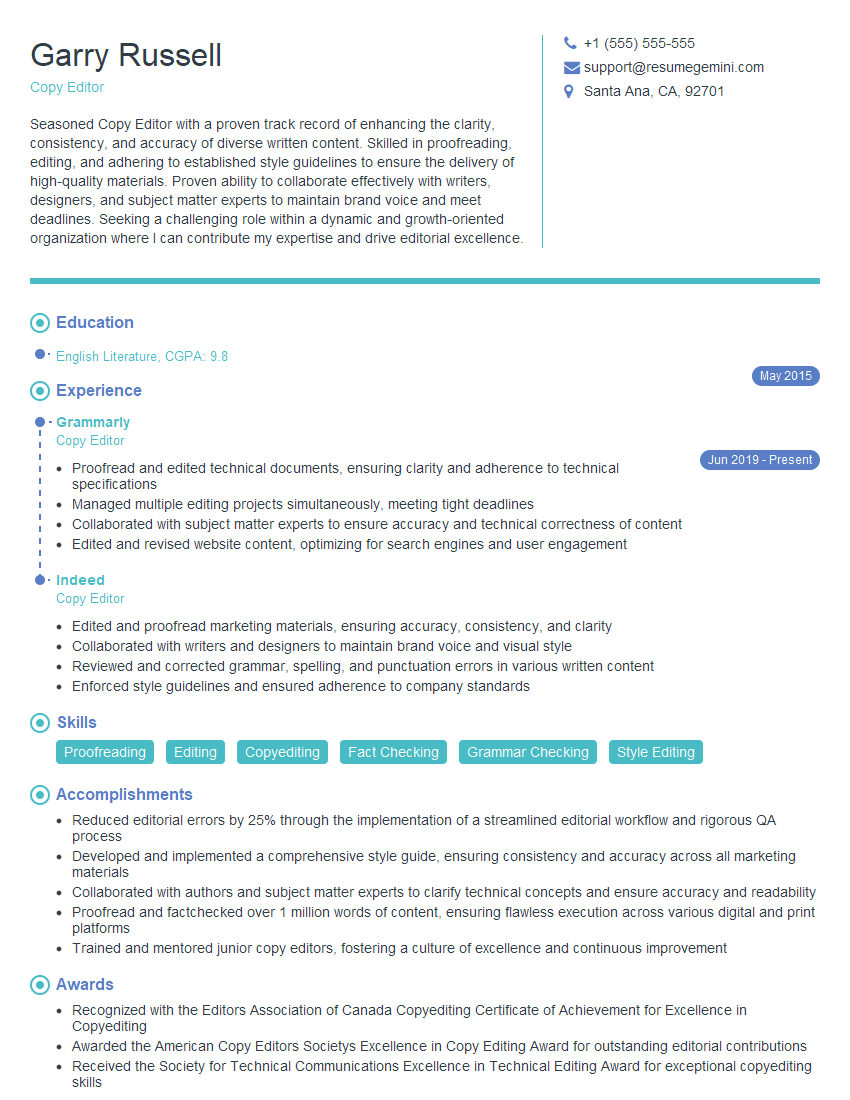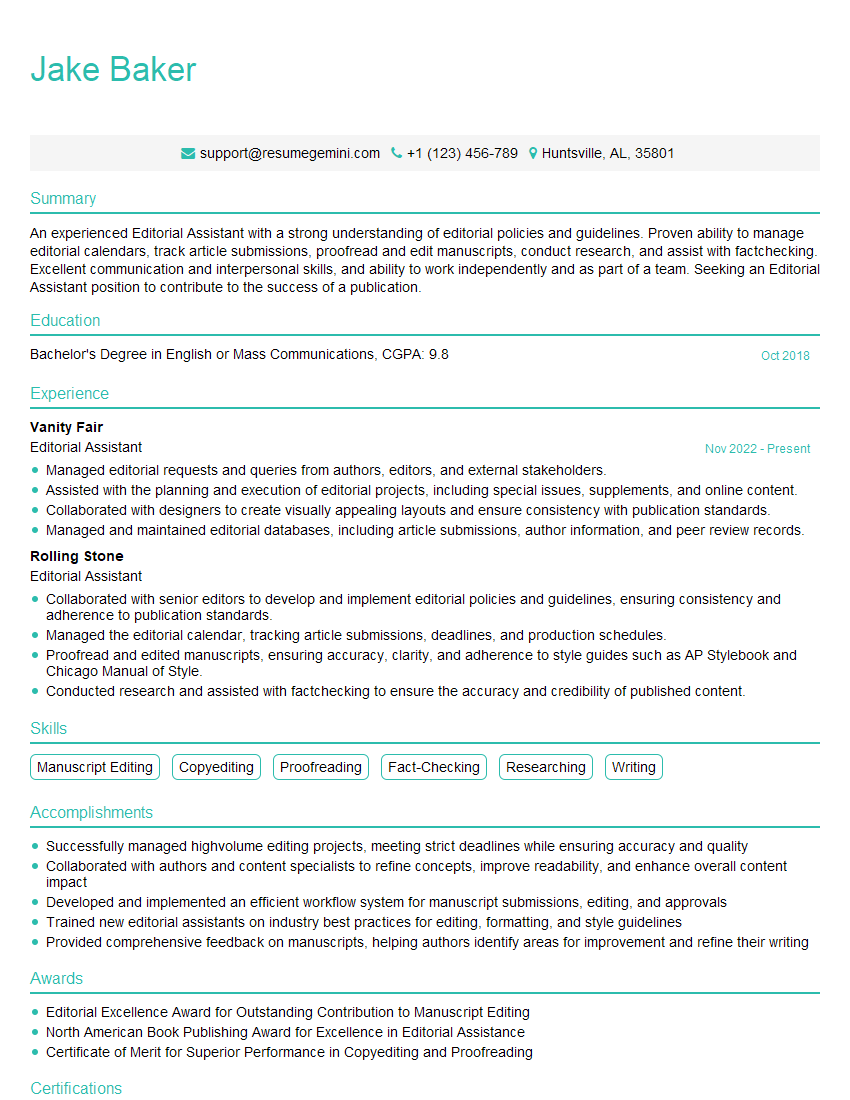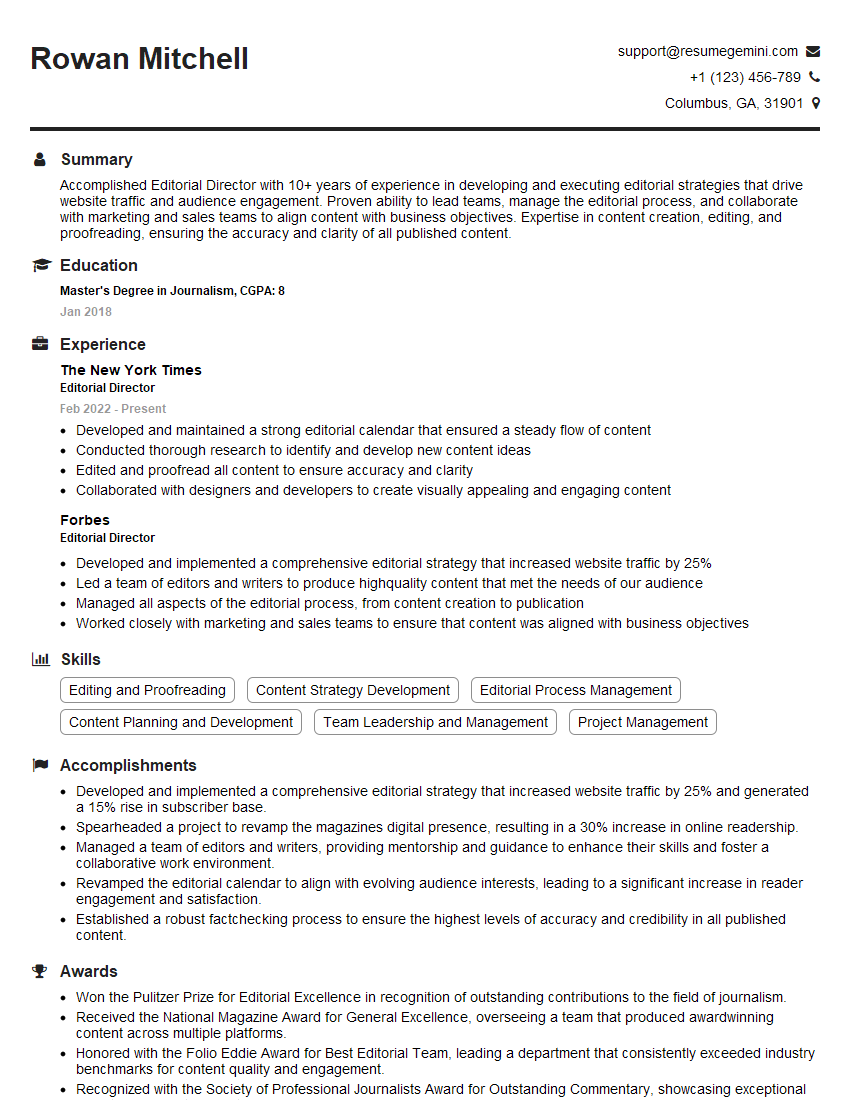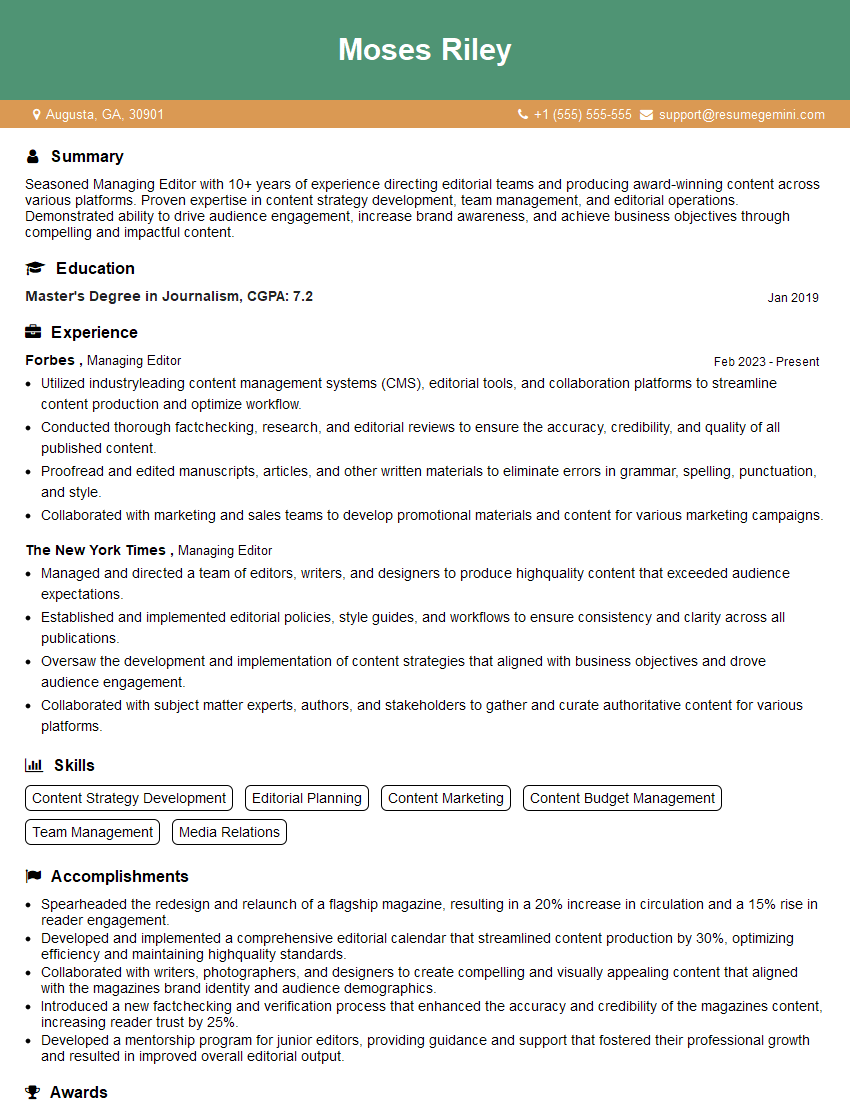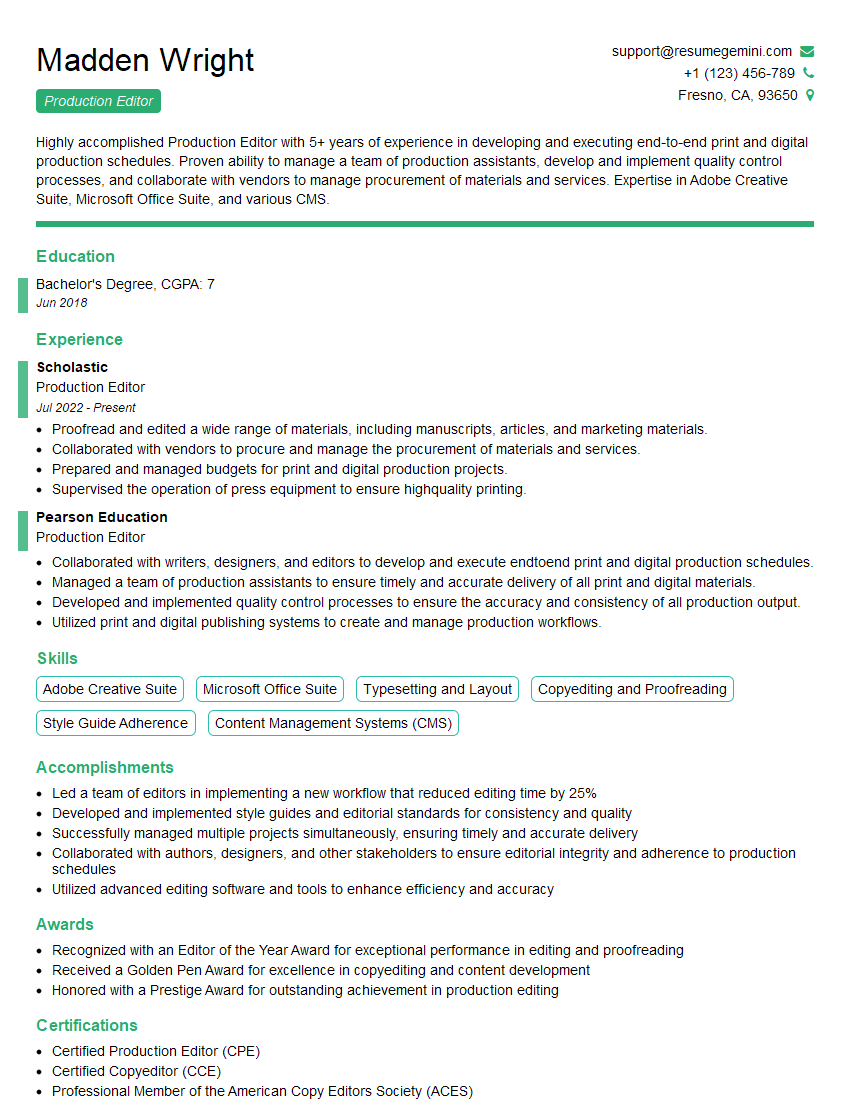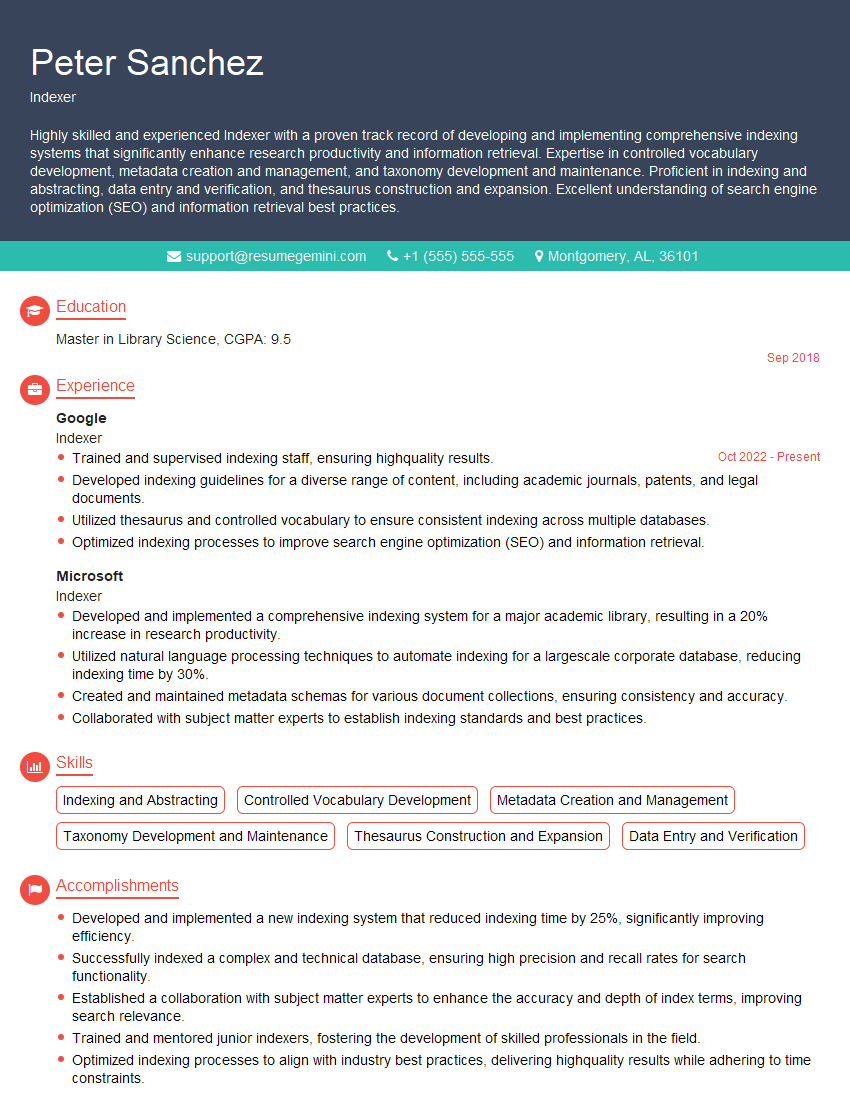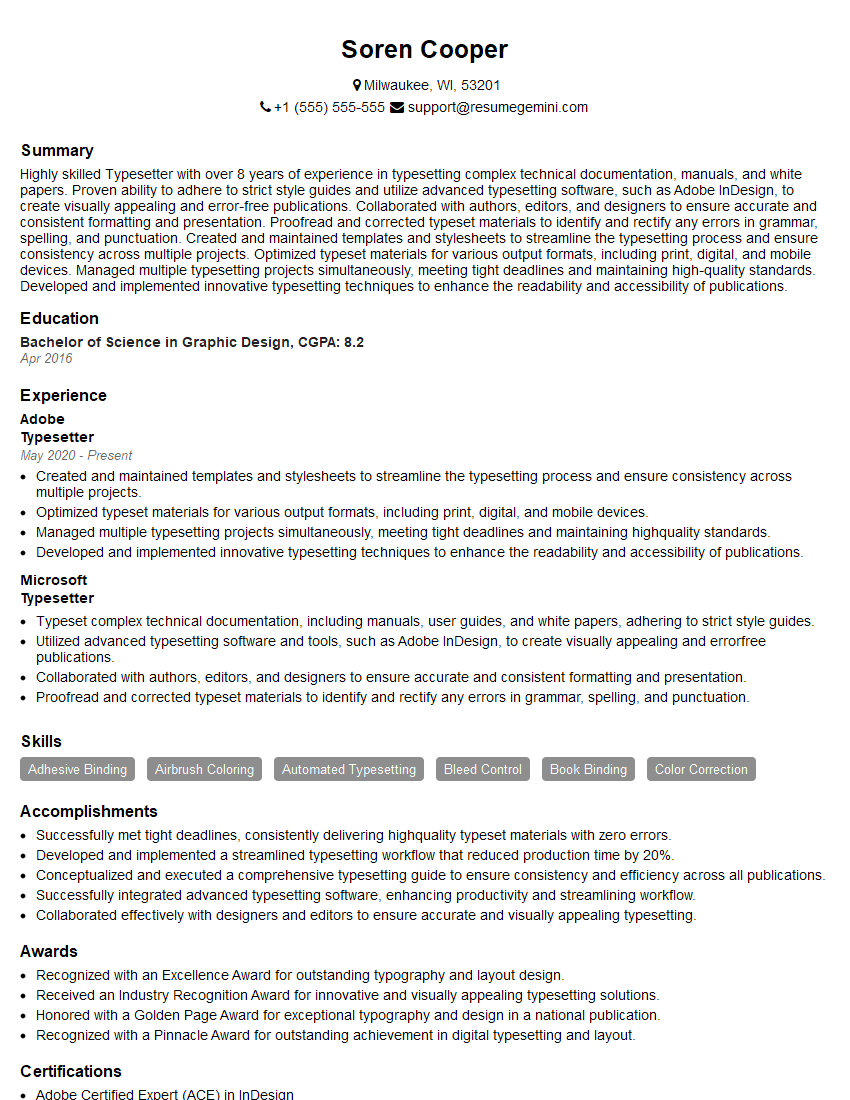Unlock your full potential by mastering the most common Academic Publishing interview questions. This blog offers a deep dive into the critical topics, ensuring you’re not only prepared to answer but to excel. With these insights, you’ll approach your interview with clarity and confidence.
Questions Asked in Academic Publishing Interview
Q 1. Explain the difference between developmental editing and copyediting.
Developmental editing and copyediting are both crucial stages in the publishing process, but they focus on different aspects of a manuscript. Think of it like building a house: developmental editing is the architectural design, while copyediting is the interior decorating.
Developmental editing focuses on the big-picture elements of a manuscript. This includes the overall structure, argumentation, clarity of the narrative, and target audience. A developmental editor might suggest reorganizing chapters, adding or removing sections, strengthening the thesis statement, or clarifying complex concepts. They work with the author to improve the manuscript’s overall effectiveness and impact.
Copyediting, on the other hand, is a more granular process. It focuses on correcting errors in grammar, punctuation, style, consistency, and mechanics. Copyeditors ensure that the writing is clear, concise, and adheres to the publisher’s style guide. They might correct typos, fix sentence fragments, ensure consistent use of terminology, and check for factual accuracy.
Example: Imagine a manuscript about the history of coffee. A developmental editor might suggest restructuring the chapters to follow a chronological approach, adding a section on the economic impact of coffee, or clarifying the scientific aspects of caffeine. A copyeditor would then focus on correcting grammatical errors, ensuring consistent capitalization of ‘Coffee Belt,’ and standardizing the use of dates and measurements.
Q 2. Describe your experience with manuscript evaluation and selection.
My experience in manuscript evaluation and selection spans over eight years, encompassing various academic disciplines. I’ve been involved in the peer-review process for several journals, evaluating submissions based on originality, significance, rigor of methodology, clarity of presentation, and overall contribution to the field. This often involves assessing the alignment of the manuscript with the journal’s scope and target audience.
I’ve developed a keen eye for identifying high-quality manuscripts. I use a structured rubric to rate submissions across several key criteria. I pay close attention to the research methodology, ensuring it’s sound and appropriate for the research question. Equally important is evaluating the clarity and precision of the writing – a well-written manuscript is much easier to assess for its scientific merit. Furthermore, I’m adept at identifying potential conflicts of interest and ensuring ethical considerations are addressed appropriately. My selection decisions are always justified and transparent, ensuring fairness and consistency.
In one instance, I identified a manuscript that, while initially appearing weak in its presentation, showed remarkable originality in its approach to a long-standing problem in the field. After working with the authors to improve clarity and presentation, the manuscript was ultimately accepted and received significant attention from the academic community. This highlights the importance of looking beyond superficial issues to recognize the true potential of a manuscript.
Q 3. How familiar are you with different publishing workflows (e.g., Agile, Waterfall)?
I’m familiar with both Waterfall and Agile publishing workflows, understanding their strengths and weaknesses in the context of academic publishing. Waterfall, with its linear, sequential approach, works well for projects with well-defined requirements and minimal anticipated changes. However, its rigidity can hinder adaptation to unexpected issues. Academic publishing, especially in fast-paced fields, often requires flexibility.
Agile methodologies, with their iterative approach and emphasis on collaboration and feedback, offer greater flexibility. In an Agile workflow, the project is broken down into smaller, manageable sprints. This allows for adjustments based on feedback from reviewers, authors, and other stakeholders. For instance, incorporating feedback from early peer review during the editing process can significantly improve the quality of the final product. However, Agile requires strong communication and a highly collaborative team. In practice, I often find a hybrid approach – incorporating elements of both Waterfall and Agile – to be most effective, enabling efficient progress while remaining responsive to changes.
Q 4. What are your preferred methods for managing author communications?
Effective author communication is paramount. My preferred methods involve a combination of tools and strategies. Firstly, I utilize a project management system, such as Asana or Trello, to track deadlines, tasks, and communication. This provides a centralized repository for all project-related information. I also rely heavily on email for routine communication, ensuring prompt responses and clear communication.
For more complex issues or significant changes, I schedule video calls or conference calls. This allows for more nuanced discussion and avoids misunderstandings. The use of a standardized communication template helps maintain consistency and clarity in my messages. Furthermore, I’m mindful of providing regular updates to authors and keeping them informed of the progress. Maintaining a professional yet friendly approach is key to fostering a positive working relationship, ensuring open and honest communication throughout the publication process.
Q 5. How do you prioritize competing deadlines and tasks?
Prioritizing competing deadlines and tasks requires a systematic approach. I start by creating a detailed task list, assigning each task a priority level (high, medium, low) and a deadline. I then utilize tools like project management software to visually represent these tasks and their dependencies.
I employ time management techniques such as the Eisenhower Matrix (urgent/important), which helps me categorize tasks and prioritize those that are both urgent and important. I often break down large tasks into smaller, more manageable subtasks, making them less daunting and easier to track. Proactive communication with stakeholders is crucial to ensure everyone is aware of potential delays and to collaborate on finding solutions. Regularly reviewing my schedule and adjusting priorities as needed is also vital for effective time management. Flexibility and the ability to adapt are crucial when dealing with unforeseen circumstances.
Q 6. Describe your experience with proofreading and quality control procedures.
My experience with proofreading and quality control procedures is extensive. It goes beyond simply identifying typos and grammatical errors. It involves a systematic approach to ensuring the accuracy and consistency of the entire publication. I typically follow a multi-stage proofreading process. Initially, I conduct a thorough review of the manuscript for any remaining inconsistencies or errors, paying attention to formatting, style, and factual accuracy.
Following this, I often engage in a second round of review, sometimes with a colleague, to ensure a fresh perspective and catch any overlooked issues. I’m proficient in using style guides and referencing standards such as APA, MLA, and Chicago style. I also utilize software tools like grammar checkers and plagiarism detection software to ensure the highest level of quality. Finally, I maintain detailed records of all corrections and changes made, ensuring transparency and accountability. The goal is to ensure that the final product is free of errors and presented in a professional and consistent manner.
Q 7. What software and technologies are you proficient in (e.g., MS Office Suite, InDesign, LaTeX)?
I’m proficient in a range of software and technologies relevant to academic publishing. My expertise includes the MS Office Suite (Word, Excel, PowerPoint), which I utilize for everyday tasks such as document preparation, data analysis, and presentation creation. I’m also highly skilled in Adobe InDesign for layout and typesetting, particularly for creating visually appealing and professional-looking publications.
Furthermore, I’m proficient in LaTeX, a powerful typesetting system ideal for complex documents, especially those with extensive mathematical notations or specific formatting requirements commonly found in scientific and technical publications. Beyond these, I’m experienced with various project management software such as Asana and Trello, and I’m familiar with various bibliographic management tools like Zotero and Mendeley. My technical skills are constantly evolving to keep pace with advancements in the field.
Q 8. Explain your understanding of copyright and permissions.
Copyright and permissions are fundamental in academic publishing. Copyright is the legal right granted to the creator of original works, including scholarly articles, books, and images. It protects their intellectual property, giving them exclusive control over how their work is used and distributed. Permissions, on the other hand, are the authorizations needed to use copyrighted material created by someone else within your own work. This could include using a figure, quoting a passage, or adapting an existing dataset.
For example, if you want to include a graph from another published research paper in your own article, you must obtain permission from the copyright holder (usually the publisher of the original work). This involves contacting the publisher, explaining your intended use, and negotiating the terms of use, which often includes a fee. Failure to obtain necessary permissions can result in copyright infringement, leading to legal action.
Understanding copyright and permissions is crucial not only to avoid legal issues but also to maintain ethical publishing practices and respect the intellectual property rights of others. Publishers usually have dedicated teams and systems to manage permissions processes.
Q 9. How do you handle disagreements with authors regarding manuscript changes?
Disagreements with authors regarding manuscript changes are a common part of the publishing process. My approach is collaborative and focuses on clear communication and mutual understanding. It begins with carefully explaining the rationale behind suggested changes, emphasizing the importance of clarity, accuracy, and adherence to the journal’s style and scope. I would provide specific examples from the manuscript illustrating the issues and explain how proposed changes would address them.
If disagreements persist, I’d encourage a discussion involving the author, editor, and possibly peer reviewers, fostering a dialogue that prioritizes the integrity and quality of the research. The focus remains on improving the manuscript, not winning an argument. Documentation of all changes and the rationale behind them is essential throughout this process. In situations where a compromise cannot be reached, sometimes a respectful disagreement is acknowledged, with a clear explanation documented in the editorial decision letter.
Transparency and professionalism are key to navigating these situations effectively. Compromise and clear explanations are more productive than rigid adherence to a single viewpoint. The ultimate goal is to produce a high-quality publication, and this often requires a flexible approach.
Q 10. Describe your experience with the peer-review process.
I have extensive experience with the peer-review process, from both the editor’s and reviewer’s perspectives. I understand the crucial role it plays in maintaining the quality and integrity of published research. I’ve managed hundreds of submissions, overseeing the selection of appropriate reviewers, monitoring the review process, and making editorial decisions based on the reviewers’ feedback. As a reviewer myself, I’ve provided constructive criticism, highlighting strengths and weaknesses of manuscripts while respecting the authors’ work.
My experience includes working with various peer-review models, including single-blind, double-blind, and open peer review. I am well-versed in managing conflicts of interest, ensuring confidentiality, and handling delays efficiently. I am familiar with best practices for ensuring fairness, transparency, and promptness in the review process. I’m adept at synthesizing often disparate reviewer comments to create constructive and actionable feedback for authors.
A well-managed peer-review process is essential to maintaining the credibility of academic publishing, and I’m committed to upholding its highest standards.
Q 11. What are some common challenges in academic publishing, and how would you address them?
Academic publishing faces numerous challenges. One major issue is the increasing pressure to publish, which can sometimes compromise the quality of research. This pressure, coupled with limited funding for research and publishing, can lead to a rush to publication, potentially impacting the rigorous review process. Another significant challenge is the growing amount of research output, making it difficult for researchers to find relevant publications and for publishers to manage the workflow efficiently.
Furthermore, issues surrounding reproducibility and data transparency are increasingly important. Finally, there’s the ongoing debate surrounding open access publishing, balancing the benefits of wider dissemination with the costs of publication.
To address these challenges, a multi-pronged approach is needed. Promoting robust research ethics, streamlining the publishing workflow through technology, improving transparency in data sharing, fostering collaborative efforts among researchers, and exploring sustainable open-access models are vital steps in ensuring the future of academic publishing.
Q 12. How familiar are you with different publication formats (e.g., print, online, open access)?
I am highly familiar with different publication formats. I have experience with traditional print publications, online journals, and various open-access models. Print publications offer a tangible and archival format, though their reach may be limited compared to online options. Online journals provide broader accessibility and often incorporate multimedia features like videos and interactive graphics, enabling a more dynamic presentation of research. Open access, encompassing various models like gold open access (where authors pay publication fees) and green open access (where authors self-archive their work), promotes wider dissemination and broader impact.
Understanding the strengths and limitations of each format is crucial for choosing the best option for a given manuscript. For instance, highly visual research might benefit from the multimedia capabilities of online journals. Conversely, a monograph intended for a specialized audience might be better suited for print.
My understanding of these different formats extends to the technical aspects of production, including formatting, metadata management, and online hosting platforms. I can advise authors on the most effective publishing strategy, considering their research, target audience, and budget.
Q 13. What metrics do you use to assess the success of a publication?
Assessing the success of a publication involves a multifaceted approach that goes beyond simple metrics. While traditional metrics like citation counts, download numbers, and journal impact factors offer valuable insights, they don’t tell the whole story.
I consider a range of factors:
- Citation counts: Indicate the influence and impact of the research.
- Altmetrics: Capture online attention and engagement, such as social media shares and mentions.
- Download numbers: Show readership and interest in the publication.
- Reader feedback: Offers valuable insights into the clarity, usefulness, and impact of the research.
- Policy influence: Assess whether the research has influenced policy decisions or practice changes.
- Media coverage: Determines the broader reach and public awareness of the research.
A holistic approach considers both quantitative and qualitative measures, recognizing that the success of a publication is contextual and depends on its goals and target audience. For example, a highly cited paper might not be considered successful if it fails to generate any broader impact or policy change.
Q 14. How do you ensure the timely completion of projects within budget?
Ensuring timely project completion within budget requires meticulous planning, efficient resource allocation, and proactive monitoring. I employ a project management approach that involves detailed scheduling, clear communication, and regular progress checks. This includes establishing realistic deadlines for each stage of the publication process, from manuscript submission to final publication. I work collaboratively with authors, reviewers, production staff, and other stakeholders to keep the project on track.
Budget management involves careful estimation of costs related to production, editing, permissions, marketing, and open-access fees (if applicable). Regular monitoring of expenses against the budget ensures early identification of potential overruns and allows for proactive adjustments. Furthermore, I leverage project management tools and software to track progress, manage deadlines, and facilitate communication effectively. This ensures transparency and accountability throughout the process.
Proactive communication and risk management are crucial. Addressing potential delays or budget issues early prevents major setbacks. A flexible approach, adaptable to unforeseen circumstances, is essential for achieving timely and cost-effective publication.
Q 15. Describe your experience with budget management and financial reporting.
Budget management and financial reporting in academic publishing are crucial for ensuring the financial health of a journal or publishing house. My experience encompasses developing and managing budgets, tracking expenses against projected costs, and preparing comprehensive financial reports for stakeholders. This includes forecasting revenue based on subscription models, author fees (for open access publications), and potential grants or subsidies. I’m proficient in using various financial software to track income and expenditures, create detailed budget breakdowns (e.g., by article type, production stage, marketing campaign), and produce regular financial reports including profit and loss statements, balance sheets, and cash flow projections. For example, in my previous role, I successfully implemented a new budgeting system that improved accuracy and reduced reporting time by 20%, leading to better resource allocation and informed decision-making.
Furthermore, I’m experienced in identifying cost-saving measures without compromising quality. This could involve negotiating better deals with vendors, optimizing production workflows, or exploring alternative publishing technologies. A specific example would be identifying a more cost-effective printing partner that resulted in a 15% reduction in production costs for a high-volume journal without affecting print quality.
Career Expert Tips:
- Ace those interviews! Prepare effectively by reviewing the Top 50 Most Common Interview Questions on ResumeGemini.
- Navigate your job search with confidence! Explore a wide range of Career Tips on ResumeGemini. Learn about common challenges and recommendations to overcome them.
- Craft the perfect resume! Master the Art of Resume Writing with ResumeGemini’s guide. Showcase your unique qualifications and achievements effectively.
- Don’t miss out on holiday savings! Build your dream resume with ResumeGemini’s ATS optimized templates.
Q 16. How do you stay up-to-date with industry trends and best practices?
Staying current in the dynamic academic publishing landscape requires a multi-pronged approach. I regularly attend industry conferences, such as those hosted by the Association of Learned & Professional Society Publishers (ALPSP) or the International Association of Scientific, Technical and Medical Publishers (STM), to network with peers and learn about the latest trends and technologies. I actively participate in webinars and online courses offered by leading publishing organizations and educational institutions. This continuous learning helps me stay informed about evolving open access models, new technologies (such as AI in peer review), and changes in copyright regulations.
Beyond formal events, I meticulously follow influential academic publishing journals and trade publications, and I regularly read industry blogs and reports. I also actively engage with online communities and discussion forums, such as those on social media platforms dedicated to publishing professionals, allowing me to stay updated on current best practices and challenges.
Q 17. What strategies do you use to market and promote academic publications?
Marketing and promoting academic publications effectively requires a balanced approach leveraging both traditional and digital strategies. For traditional methods, I focus on developing compelling marketing materials, such as brochures and journal flyers, that highlight the journal’s scope, impact factor, and target audience. I also build relationships with librarians and other key decision-makers in academic institutions to ensure our publications are prominently displayed in library catalogues and promoted through institutional newsletters.
In the digital realm, I utilize a multi-channel approach. This includes search engine optimization (SEO) to enhance the visibility of publications online, strategic social media marketing to engage with potential readers and authors, and the use of email marketing campaigns to announce new publications and journal updates. I also work on developing and managing the publication’s website, making sure it’s user-friendly, mobile-responsive, and includes features like online submission systems and article-level metrics to track engagement. For example, I’ve previously spearheaded campaigns that utilized targeted advertising on relevant academic platforms, resulting in a 30% increase in article downloads.
Q 18. How do you build and maintain positive relationships with authors and other stakeholders?
Building and maintaining positive relationships with authors and other stakeholders is critical to success in academic publishing. I believe in fostering open communication, providing timely and constructive feedback, and treating everyone with respect and professionalism. With authors, this involves clear communication throughout the publication process – from manuscript submission to publication and beyond. I strive to offer helpful guidance on manuscript preparation, peer review feedback, and publication ethics. I believe in being responsive to author queries and address any concerns promptly and transparently.
With other stakeholders, such as editorial board members, reviewers, and librarians, I build strong relationships through regular communication, appreciation for their contributions, and a commitment to collaboration. This could involve regular meetings, feedback sessions, or even informal networking opportunities at conferences. Regular surveys and feedback mechanisms help ensure I am meeting their needs and expectations. For example, I have initiated regular feedback sessions with our editorial board, leading to a more streamlined and efficient review process and improved journal quality.
Q 19. Describe your experience with managing a team or leading a project.
I have extensive experience in managing teams and leading projects within academic publishing. In my previous role, I managed a team of five editors, overseeing their workload, providing guidance on editorial best practices, and conducting performance reviews. I developed and implemented project management plans for major journal launches, encompassing all stages from initial planning and budget allocation to final publication and marketing. I utilize project management tools to track progress, manage timelines, and ensure that projects are delivered on time and within budget. My leadership style is collaborative and supportive, focusing on empowering team members and fostering a positive work environment.
For example, I successfully led a project to migrate a major journal to a new publishing platform. This involved coordinating the work of multiple team members, managing the technical aspects of the migration, and ensuring minimal disruption to the publication schedule. The project was completed on time and under budget, resulting in improved functionality and reader experience. My approach emphasizes clear communication, regular check-ins, and open feedback sessions to resolve challenges proactively.
Q 20. Explain your understanding of open access publishing models and their implications.
Open access (OA) publishing is a model where research outputs are freely available online to anyone, without financial, legal, or technical barriers. Several OA models exist, including: Gold OA, where authors pay an article processing charge (APC) to have their work published in an OA journal; Green OA, where authors self-archive their work in a repository; and hybrid OA, where some articles in a subscription-based journal are made OA for a fee.
The implications of OA are significant. It promotes wider dissemination of research, increases research impact, and potentially accelerates scientific progress. However, OA also presents challenges, including the sustainability of OA journals given the reliance on APCs, issues of equity and access for researchers in low-income countries, and concerns about the quality control of OA publications. A key aspect is understanding the various OA licenses (e.g., Creative Commons) and ensuring compliance with copyright and licensing agreements.
Q 21. How do you balance the needs of authors with the requirements of publishers and readers?
Balancing the needs of authors, publishers, and readers requires a nuanced understanding of the various stakeholders’ interests and priorities. Authors want their research to be widely disseminated, receive appropriate credit, and undergo a fair and efficient peer-review process. Publishers need to ensure financial sustainability, maintain quality standards, and meet the needs of their readers. Readers expect access to high-quality, trustworthy research that is easily discoverable and accessible.
This delicate balance necessitates a collaborative approach. I ensure open communication with authors, actively addressing their concerns and feedback. I work closely with editorial boards to uphold high quality standards and ensure a rigorous peer-review process. I consider the needs of readers by employing user-friendly online platforms, making publications easily searchable and accessible, and providing robust article metadata. For example, I’ve worked with authors to find creative solutions to meet publication fees for OA publications while prioritizing high-quality research. In practice, this often involves working with funding agencies or finding alternative funding solutions.
Q 22. What is your experience with data analysis relevant to publication performance?
My experience with data analysis in academic publishing centers on using metrics to understand and improve publication performance. This involves more than just looking at raw numbers; it’s about interpreting trends and drawing actionable insights. For instance, I’ve extensively used citation analysis to track the impact of publications, examining metrics like the number of citations, citation half-life, and h-index. This helps assess the long-term influence of a journal or individual articles. Beyond citations, I’m proficient in analyzing download statistics, altmetrics (social media mentions, news coverage), and article processing charges (APCs) data to understand readership, engagement, and the financial health of publications. I’ve used this data to inform decisions about journal scope, marketing strategies, and pricing models, ultimately leading to increased visibility and impact.
For example, in a recent project, I analyzed the citation patterns of a specific journal over a five-year period. By identifying articles with unusually high citation rates, we were able to understand what topics resonated most with the research community, leading to targeted calls for papers on those subjects. This data-driven approach helped the journal increase its impact factor significantly.
Q 23. Describe your understanding of different citation styles (e.g., APA, MLA, Chicago).
My understanding of citation styles encompasses the most prevalent ones used in academic publishing: APA, MLA, and Chicago. Each has its unique format for in-text citations and bibliography entries, reflecting different disciplinary conventions. The APA style (American Psychological Association) is widely used in the social sciences, emphasizing author-date citations. The MLA style (Modern Language Association) is common in the humanities, focusing on author-page citations. The Chicago style offers two main systems: the author-date system, similar to APA, and the notes-bibliography system, which uses footnotes or endnotes.
The key differences lie in how sources are cited within the text and presented in the reference list. For example, a book cited in APA style might appear as (Author, Year, p. #) in-text and with a full bibliographic entry in the reference list, whereas in MLA style, the in-text citation might be (Author page #) and the entry in the ‘Works Cited’ list would differ in formatting.
Proficiency in these styles is crucial for ensuring consistency, accuracy, and credibility in scholarly publications. My experience includes training authors on proper citation practices and implementing automated style checks to maintain high editorial standards.
Q 24. How familiar are you with ISBN and DOI assignment processes?
ISBNs (International Standard Book Numbers) and DOIs (Digital Object Identifiers) are essential for identifying and tracking publications, especially in the digital age. ISBNs are unique alphanumeric codes assigned to books and book-like publications, primarily used for inventory management and bookselling. DOIs, on the other hand, are persistent identifiers for any digital object, including journal articles, book chapters, and datasets. They provide a stable, resolvable link to the online version of a publication, even if the URL changes.
I’m familiar with the processes of assigning both. ISBNs are typically obtained through national ISBN agencies, and the process often involves registering with the agency and providing publication details. DOIs are assigned through registration agencies like CrossRef, and the process often involves metadata submission that ensures accurate and persistent linking. My experience includes working with publishers to ensure accurate ISBN and DOI assignments for all their publications, contributing to better discoverability and management.
Q 25. How would you handle a situation where an author submits a manuscript that is not suitable for publication?
Handling unsuitable manuscripts requires a delicate balance of professionalism and clarity. First, I’d conduct a thorough review of the manuscript, considering its relevance to the journal’s scope, methodological rigor, originality, and overall quality. If the manuscript is deemed unsuitable, I’d prepare a detailed, yet considerate, rejection letter. This letter would clearly explain the reasons for rejection, focusing on specific aspects needing improvement (e.g., lack of novelty, methodological flaws, or poor writing quality). I would avoid generic rejections. The goal is to provide constructive feedback that helps the author improve their work for future submissions, potentially elsewhere.
Depending on the reason for rejection, I might suggest alternative journals better suited for the manuscript’s topic or methodology. Offering constructive feedback is essential, even in rejection, as it fosters a positive author experience and encourages future submissions to the wider scholarly community. This approach promotes a reputation for fairness and fosters a healthy relationship between authors and the publisher.
Q 26. How do you ensure the ethical and responsible conduct of publishing activities?
Ensuring ethical and responsible conduct in publishing is paramount. This involves adhering to strict guidelines on plagiarism detection, authorship disputes, data manipulation, and conflicts of interest. We use advanced plagiarism detection software to screen manuscripts for originality. Clear authorship guidelines are provided to authors upfront, outlining criteria for authorship contribution and addressing potential disputes. We have a robust process for handling allegations of research misconduct, involving independent investigations and following established COPE (Committee on Publication Ethics) guidelines. A transparent system for managing conflicts of interest is also in place, requiring authors to disclose any potential conflicts during the submission process.
Beyond this, we emphasize transparency in peer review, fostering open communication between authors and reviewers. We continuously update our policies and procedures to adapt to evolving ethical standards and best practices in the industry. Regular training for editorial staff on research ethics and publishing best practices is also vital.
Q 27. Describe your experience with working with freelancers and external vendors.
I have extensive experience collaborating with freelancers and external vendors, including copyeditors, proofreaders, typesetters, and designers. I’ve managed projects successfully by clearly defining scopes of work, setting realistic deadlines, establishing effective communication channels (e.g., project management software), and providing regular feedback. I prioritize building strong working relationships with freelancers, fostering trust and mutual understanding. This often involves transparent communication regarding project timelines, payment terms, and expected deliverables.
For instance, I’ve successfully managed a team of freelancers responsible for copyediting over 50 manuscripts simultaneously, ensuring consistent quality and timely delivery. This involved setting clear style guides, using a collaborative platform for feedback, and proactively addressing any issues or delays. Experience with vendors includes negotiating contracts, ensuring compliance with copyright and usage rights, and managing budgets effectively.
Q 28. What are your salary expectations for this role?
My salary expectations for this role are commensurate with my experience and skills in academic publishing. Considering my expertise in data analysis, editorial management, ethical practices, and vendor collaboration, I’m seeking a competitive salary within the range of [Insert Salary Range] annually. I’m open to discussing this further based on the specifics of the role and benefits package.
Key Topics to Learn for Academic Publishing Interview
- Manuscript Submission & Workflow: Understanding the entire publication process, from initial submission to final publication, including author communication, peer review processes, and editorial decisions.
- Copyright & Intellectual Property: Practical application of copyright law within the publishing context; understanding licensing agreements and open access models.
- Journal Management Systems (JMS): Familiarity with different JMS platforms and their functionalities; experience with data entry, manuscript tracking, and reporting.
- Editorial Processes & Standards: Knowledge of style guides (e.g., Chicago Manual of Style, APA), editing principles, and proofreading techniques.
- Marketing & Sales Strategies in Academic Publishing: Understanding the target audience for academic publications and strategies for promoting and selling journals and books.
- Production & Pre-press: Practical understanding of the steps involved in transforming a manuscript into a final published product, including typesetting, design, and printing.
- Open Access Publishing Models: Understanding the various business models and their implications for authors, publishers, and readers.
- Data Management & Analytics: Using data to inform editorial decisions and track the performance of publications.
- Ethical Considerations in Publishing: Understanding and applying ethical standards related to plagiarism, authorship, and conflict of interest.
Next Steps
Mastering the intricacies of academic publishing opens doors to a rewarding career with significant intellectual stimulation and contribution to the global dissemination of knowledge. A strong resume is crucial for securing your dream role. Creating an ATS-friendly resume maximizes your chances of getting noticed by recruiters. We highly recommend using ResumeGemini to build a professional and impactful resume that highlights your skills and experience effectively. ResumeGemini provides examples of resumes tailored specifically to the Academic Publishing industry, ensuring your application stands out from the competition.
Explore more articles
Users Rating of Our Blogs
Share Your Experience
We value your feedback! Please rate our content and share your thoughts (optional).
What Readers Say About Our Blog
Interesting Article, I liked the depth of knowledge you’ve shared.
Helpful, thanks for sharing.
Hi, I represent a social media marketing agency and liked your blog
Hi, I represent an SEO company that specialises in getting you AI citations and higher rankings on Google. I’d like to offer you a 100% free SEO audit for your website. Would you be interested?

